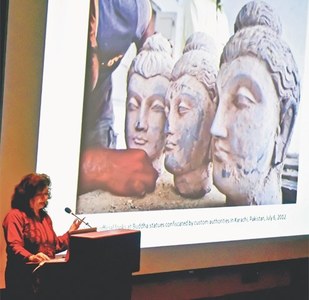
SAQQARA: Archaeologists in Egypt have unearthed two human and animal embalming workshops, as well as two tombs, discovered in the Saqqara necropolis south of Cairo, the government said on Saturday.
The vast burial site, at the ancient Egyptian capital Memphis, is a Unesco World Heritage site and home to more than a dozen pyramids, animal graves and old Coptic Christian monasteries.
Mostafa Waziri, head of Egypt’s Supreme Council of Antiquities, told reporters the embalming workshops, where humans and animals were mummified, “date back to the 30th dynasty” which reigned around 2,400 years ago.
Researchers “found several rooms equipped with stony beds where the deceased lay down for mummification”, Egypt’s tourism and antiquities ministry said.
Each bed ended in gutters to facilitate the mummification process, with a collection of clay pots nearby to hold entrails and organs, as well as a collection of instruments and ritual vessels.
Early studies of the other workshop suggest it was used for the “mummification of sacred animals”. The discovery also includes the tombs of two priests dating back to the 24th and 14th centuries BC, respectively.
The first belonged to Ne Hesut Ba, who served the fifth dynasty as the head of scribes and priest of the gods Horus and Maat.
The tomb walls are decorated with depictions of “daily life, agriculture and hunting scenes”, said Mohamed Youssef, director of the Saqqara archaeological site.
The second tomb, that of a priest named Men Kheber, was carved in rock and features depictions of the deceased himself on the tomb walls, as well as in a one-metre-long (three foot) alabaster statue, Youssef told reporters.
Egypt has unveiled a string of major archaeological discoveries in recent years.
Critics say the flurry of excavations has prioritised finds shown to grab media attention over hard academic research.
The discoveries have been a key component of Egypt’s attempts to revive its vital tourism industry amid a severe economic crisis.
The government recently launched a strategy “aiming for a rapid increase in inbound tourism” at a rate of 25-30 per cent a year, Tourism and Antiquities Minister Ahmed Issa said at the site on Saturday.
Egypt aims to draw in 30 million tourists a year by 2028, up from 13 million before the Covid pandemic.
The crowning jewel of the government’s strategy is the long-delayed inauguration of the Grand Egyptian Museum at the foot of the pyramids in Giza.
Published in Dawn, May 28th, 2023














































Dear visitor, the comments section is undergoing an overhaul and will return soon.